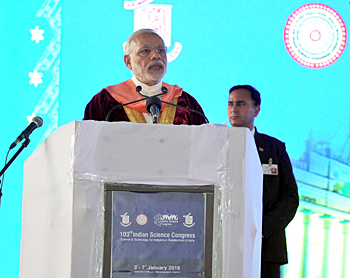INDIAN ARMED FORCES CHIEFS ON OUR RELENTLESS AND FOCUSED PUBLISHING EFFORTS

SP Guide Publications puts forth a well compiled articulation of issues, pursuits and accomplishments of the Indian Army, over the years

"Over the past 60 years, the growth of SP Guide Publications has mirrored the rising stature of Indian Navy. Its well-researched and informative magazines on Defence and Aerospace sector have served to shape an educated opinion of our military personnel, policy makers and the public alike. I wish SP's Publication team continued success, fair winds and following seas in all future endeavour!"

Since, its inception in 1964, SP Guide Publications has consistently demonstrated commitment to high-quality journalism in the aerospace and defence sectors, earning a well-deserved reputation as Asia's largest media house in this domain. I wish SP Guide Publications continued success in its pursuit of excellence.
Technology Vision 2035 what about defence?
 |
By Lt. General P.C. Katoch Former Director General of Information Systems, Indian Army |
The Technology Information, Forecasting and Assessment Council (TIFAC) under the Ministry of Science & Technology has come out with 'Technology Vision 2035,' identifying the challenges ahead and how they can be dealt with through technological interventions while realizing the dream of a developed India by the year 2035. It gives details of 12 sectors and technologies that in some cases exist but need to be deployed, some in the pilot stage that must be scaled up and technologies in R&D stage.

The vision talks about future technologies ranging from flying cars, real time translation software, personalized medicine, wearable devices, e-sensing (e-nose and e-tongue) to 100% recyclable materials among others which may be used in different areas to solve day-to-day problems. The document was released by the Prime Minister Narendra Modi after he inaugurated the 103rd Indian Science Congress in Bangalore recently, promising his government would "make it easier to do science and research" in India and envisioned a future in which innovation makes lives of people better. Interestingly, the document also talks of ‘Blue Sky Research’; imagination that may lead to reality through curiosity driven, paradigm shattering research like virtual courts and digital evidence, complex real-time dynamic disaster management response systems, sensing devices to be able to feel the product on internet before buying it, machines / robots to connect all personal and emotional needs, intelligence vehicles to detect emergency situations and take over the control and inter-planetary communications systems and the like. Besides the key sectors like health, education, transport, energy, food\agriculture and manufacturing, the Technology Vision 2035 also mentioned environment, information & communication technologies, infrastructure, materials, habitat and water as important areas where future technologies will be able to solve day-to-day problems of citizens by better utilization of available resources and skilled manpower. Significantly, the first such document ‘Technology Vision 2020’ had come under Dr APJ Abdul Kalam in 1996.
It would be fruitful to list out how much we have actually progressed under the first such vision because that would indicate where the pitfalls and problems are. But this takes us to the ‘Technology Perspective and Capability Roadmap (TPCR) issued in April 2013 by HQ IDS with a forward by the then Defence Minister AK Anthony. It lists out some 19 key technological requirements: one, Battlefield Transparency; two, Command and Control Architecture; three, Communication Systems; four, Smart Radios; five, Information Dominance; six, Electronic Warfare; seven, Nano Technology / Micro Electro-Mechanical Systems (MESM), eight, Artificial Intelligence and Robotics; nine, Chemical, Biological, Radiological and Nuclear (CBRN) Defence; nine, Miniaturization; ten, Unmanned Systems; ten, Advanced Weapon Systems PGMs, air-to-air weapons, Hard Kill Weapons; eleven, Electro-Magnetic Pulse (EMP) Weapons; twelve Adaptive Warheads; twelve, Weapon Guidance; thirteen, Space-Based Radars; fourteen, Stealth, fifteen, Digital Systems; sixteen, Adaptive Antenna Signatures; seventeen, SAGW; eighteen, Sensors; and nineteen, Sensor Fusion. There is further elaboration in terms of aviation, land warfare and maritime. The TPCR covers the period 2012-2027. The question that arise here are whether a mere forward by the Defence Minister on the TPCR enough to consider it a MoD document? If so, should the preamble not have listed out the futuristic threats including ongoing hybrid and asymmetric wars? What about self-sufficiency in semi-conductors, computers and telecommunication equipment? What about exploiting technologies like Steerable Beam Technology, Wide Band / Software Defined Radios, Network Security, Common GIS, Data Fusion & Analysis, Alternatives to GPS, Dynamic Bandwidth Management, Shooting down UAVs electronically or through other means, Camouflage etc? What about ‘blue sky research’ in defence? How about ‘mind control’? Considering that the TPCR commenced 2012, what is the progress that is made in the last five years, if at all? The fact is that presently the military does not even have common data structures, symbology and interoperable protocols; true ‘system of systems’ approach appears decades away. The status of the military’s C4I2SR is nowhere near the required. Even the mapping requirements are decades behind schedule. Does the MoD itself have attitudinal change to accommodate the concept of NCW? These are hardly issues that the MoD should be glossing over? Issuing a TPCR by itself is only a small part. A review every 3-5 years and periodic corrective actions are must.
Photo Credit: PIB





